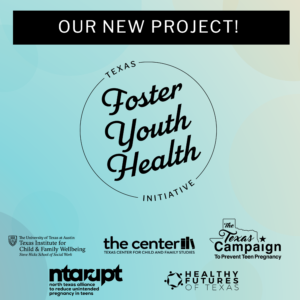The Texas Institute for Child & Family Wellbeing receives $5.4 million-dollar grant for The Texas Foster Youth Health Initiative
Austin, TX. About 50% of females who experience foster care in the United States are pregnant by age 19 compared to only 33% of girls across the nation who have a pregnancy by that age.[1] Despite disproportionately high pregnancy rates, there are limited interventions and community strategies to help reduce teen pregnancy among foster youth. With a $5.4 million three year grant, the Texas Institute for Child & Family Wellbeing (TXICFW) within the Steve Hicks School of Social Work will lead the Texas Foster Youth Health Initiative to build relationships across child welfare and adolescent health systems to promote optimal health for child welfare-involved youth.
In partnership with the Texas Campaign to Prevent Teen Pregnancy and the Texas Alliance of Child and Family Services, the Texas Foster Youth Health Initiative will establish, fund, coordinate, and support a multidisciplinary network of community partners to develop and test cutting edge sexual health interventions for youth and their caregivers. These community partners include Healthy Futures of Texas and the North Texas Alliance to Reduce Unintended Pregnancy in Teens (Ntarupt).
“We are really excited because this project is finally bridging relationships and resources between child welfare agencies and health education providers,” said Monica Faulkner, Ph.D., LMSW, Principal Investigator for the Texas Foster Youth Health Initiative. “The foster care system is often blamed for high rates of teen pregnancy, but the reality is that youth have experienced sexual violence and witnessed domestic partner abuse prior to entering foster care. They lack foundations for healthy relationships, but healthy relationships are critical for healing trauma. The foster care system can provide that foundation. But, in the past, we have encountered many child welfare workers and caregivers who understand trauma, but lack effective tools to have conversations about health and relationships; and health educators who are comfortable talking about health and relationships, but who lack a deep understanding and tools to address trauma.”
The Texas Foster Youth Health Initiative will support efforts in San Antonio, Dallas, the Rio Grande Valley and Houston to bring together local leaders from child welfare agencies and health education providers to assess the needs for training and interventions to build skills among youth and caregivers. Communities will be offered options to develop their own interventions and resources, or use and adapt existing resources to meet the identified needs of that community. One additional community will be added in the second year of the project.
“When I was working as a case manager for foster youth, I remember searching for resources to help me work with youth, but nothing seemed relevant to the realities of the youth” said Monica Faulkner, Ph.D., LMSW, Principal Investigator for the Texas Foster Youth Health Initiative. “My greatest hope is that this project will provide a framework for communities across the nation to start to better support youth. I am really proud that Texas will lead these efforts.”
This grant was one of 13 given to organizations for “Tier 2 Innovation and Impact Network Grants: Achieving Optimal Health and Preventing Teen Pregnancy in Key Priority Areas” by the Office of Population Affairs through the U.S. Department of Health & Human Services. The Texas Institute for Child & Family Wellbeing was one of two grantees designated to address optimal adolescent health, teen pregnancy, and STIs for youth in foster care and/or the child welfare system.
For more information about this project, please contact TXICFW Communications Director, Kate McKerlie, katelynmckerlie@austin.utexas.edu
[1] Eastman, A.L., Palmer, L. & Ahn. E. (2019) Pregnant and parenting youth in care and their children: A literature review. Child and Adolescent Social Work Journal, 10.1007/s10560-019-00598-8

